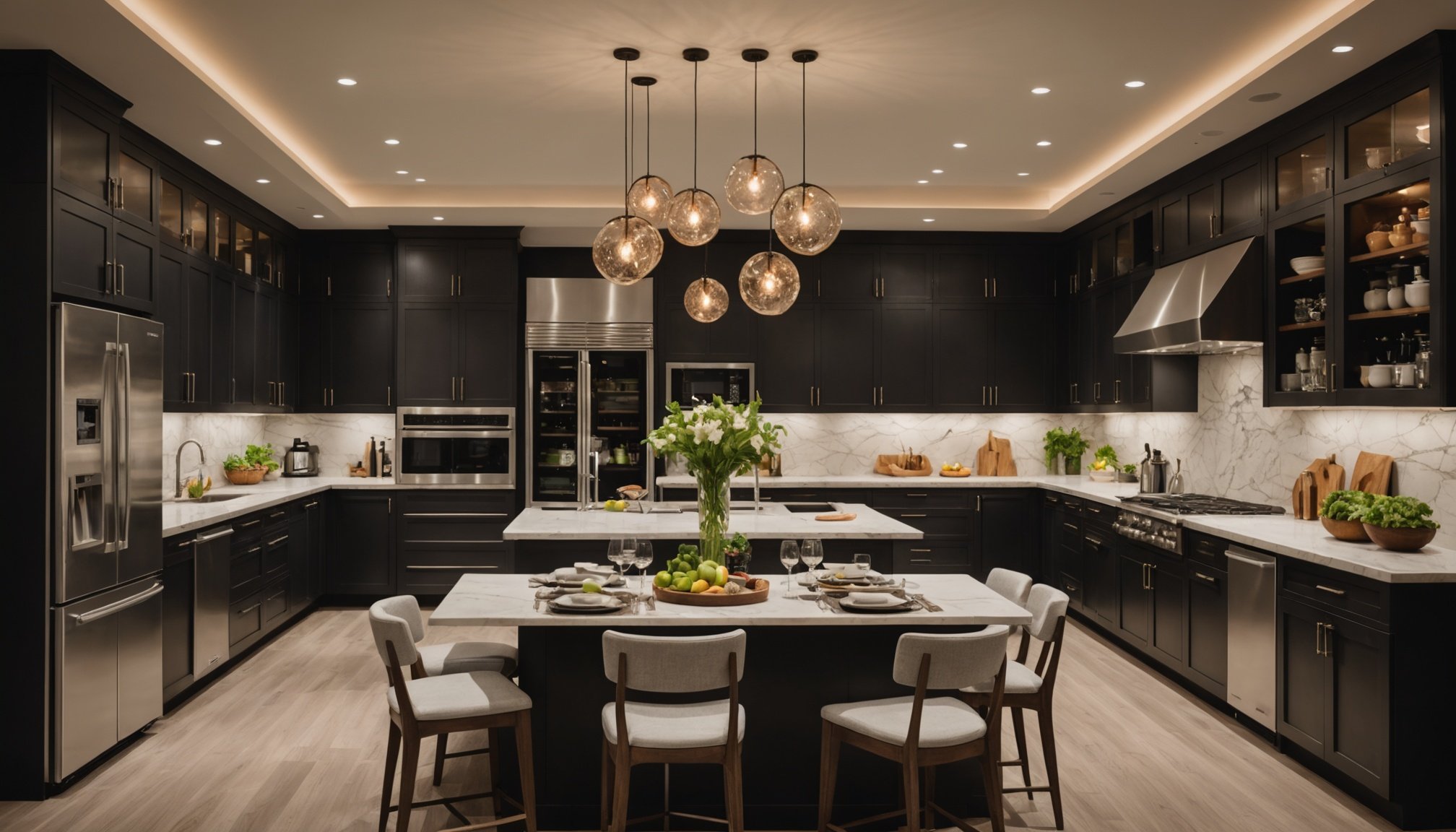Understanding the Importance of Lighting in Culinary Spaces
Creating the right kitchen lighting setup is crucial for both functionality and ambiance. The choice between natural and artificial light can significantly influence how tasks are performed. Natural light, streaming in through windows, offers a warm and inviting glow, making it ideal for daytime culinary activities. On the other hand, artificial lighting ensures that your kitchen is well-lit regardless of the time, allowing for precise cooking and safe food preparation.
Enhancing Kitchen Functionality
Proper lighting can enhance the kitchen’s functionality by illuminating workspaces effectively. This is particularly important for tasks that require attention to detail, such as chopping or measuring ingredients. A combination of overhead lights and under-cabinet LEDs can provide targeted illumination, reducing shadows and improving visibility.
Topic to read : Choosing the ideal kitchen sink size to suit your family”s specific requirements
Dining Atmosphere and Presentation
Lighting also plays a pivotal role in the dining experience by setting the mood and enhancing food presentation. The right balance of light affects the dining atmosphere, creating a welcoming and cozy environment. Dim, warm lights can transform a meal into a memorable experience, encouraging conversation and relaxation. Additionally, well-placed lighting highlights the colours and textures of dishes, making them more enticing to diners.
Incorporating both natural and artificial light thoughtfully can significantly elevate the culinary space, blending practicality with aesthetic appeal for a complete dining experience.
Also to read : Transforming kitchen safety: discover creative iot solutions for a secure culinary journey
Natural Lighting Techniques
Harnessing natural light in your kitchen can transform the ambiance, making it both inviting and functional. One effective strategy is to focus on window placement. Position windows on the east or west sides to optimize sunlight exposure throughout the day. Large windows can flood your kitchen with light, while smaller, strategically placed windows can brighten hard-to-reach areas.
Incorporate reflective surfaces to amplify the effect. Using light-coloured countertops or glossy finishes on cabinets can enhance natural illumination by bouncing light around the space. This not only brightens the area but can also create a sense of openness and space.
The size of the windows is equally vital. Larger windows or glass doors that lead outdoors can create a seamless transition between the indoor and outdoor spaces, inviting more light in. Skylights are another fantastic option, especially in kitchens that may lack wall space for additional windows.
The choice and arrangement of your window treatments play a role too. Sheer or light-filtering materials allow light to enter while maintaining privacy. Avoid heavy curtains or blinds that can block out sunlight.
Remember, maximizing natural light is about creating a balance—ensuring functionality while maintaining a beautiful, bright kitchen environment.
Artificial Lighting Solutions
Artificial lighting in kitchens often involves a blend of ambient, task, and accent lighting to create a well-lit and functional space. Each type serves a distinct purpose. Ambient lighting provides overall illumination, task lighting focuses on specific areas like countertops, and accent lighting highlights architectural features or decor.
Among various light sources, LED lights have revolutionised artificial lighting due to their energy efficiency and longevity. Compared to incandescent bulbs, LEDs consume less power and have a longer lifespan, making them both cost-effective and environmentally friendly. However, their upfront cost can be higher. On the other hand, incandescent bulbs offer warmer tones but are less energy-efficient and have a shorter life span. Fluorescent lights, typically found in older kitchens, are efficient but often lack warmth and can flicker.
When choosing kitchen fixtures, it’s important to consider both style and function. Sleek, modern designs often incorporate LED options due to their flexibility in size and colour temperature. Popular choices include under-cabinet lighting for tasks and pendant lights for specific areas like islands. These fixtures not only enhance functionality but also add a stylish touch to the kitchen, balancing practicality with aesthetics. Choosing the right balance of fixtures and light types ensures a welcoming and efficient kitchen environment.
Blending Natural and Artificial Light
Creating the perfect balance of light in culinary spaces requires expertise in synchronizing natural and artificial sources. This delicate dance enhances the ambiance and functionality of a space. Harmonizing light sources involves using techniques that capitalize on their unique qualities.
To begin, consider the spatial layout and potential for natural light. Positioning work areas near windows not only improves visibility but also aligns with daily rhythms. Essential to this process is understanding the time of day when natural light is most abundant and how it can be maximized.
As evening approaches and natural light fades, strategic use of artificial lighting becomes vital. Lighting design should focus on seamless transitions from day to night. This can be achieved by utilizing dimmers, which modulate light intensity, or layering light with different fixture types to create depth and mood. It’s about combining ambient, task, and accent lighting.
An example of successful integration is seen in restaurants that use skylights or large windows during the day, enhanced by warm overhead pendants or LED strips at dusk. The result is a cohesive environment where patrons enjoy a consistent aesthetic experience, regardless of the time. By effectively merging these light sources, spaces can be transformed to mirror the natural world’s rhythms, ensuring continuous harmony.
Lighting Techniques to Enhance Space and Mood
When it comes to lighting techniques that enhance both space perception and mood, strategic planning is essential. A well-lit area can dramatically transform a room, making it appear more spacious while creating the desired ambiance. Mood lighting plays a crucial role in this transformation, as the right light intensity and color can evoke different feelings and set the right tone for any occasion.
Layered lighting is one effective method for adjusting mood and space perception. By combining ambient, task, and accent lighting, you can create a flexible environment that caters to various activities and moods. Ambient lighting provides overall illumination, task lighting focuses on specific areas, and accent lighting highlights particular features or objects. This layered approach allows for greater control over the mood of the room.
Dimmers add another level of versatility to your lighting setup. They offer the ability to adjust the brightness according to the time of day or specific need. For instance, a brighter setting might be preferred during dinner parties, while softer lighting creates a cozy atmosphere in the evening.
In kitchens and dining rooms, effective lighting design can redefine the functionality and style of the space. Case studies often demonstrate that thoughtful lighting arrangements can enhance not only the visual appeal but also the practicality of these areas.
Visual Inspiration and Successful Implementations
Exploring lighting inspiration can transform ordinary culinary spaces into beautifully illuminated kitchens. High-quality design examples showcase how different lighting techniques create ambience and functionality. Imagine a kitchen bathed in warm under-cabinet lights that highlight polished surfaces, creating a welcoming glow. By studying successful lighting implementations, homeowners can understand how to balance natural and artificial light, tailoring it to their personal needs.
Take, for instance, the strategic use of pendant lights above kitchen islands, a popular choice in modern design examples. These illuminate workspaces without overpowering the room, contributing to an efficient, yet aesthetically pleasing, atmosphere. Combined with recessed ceiling lights, they maintain a clean, minimalistic appearance by providing even lighting coverage throughout.
Visual documentation, such as photos from design catalogs or online galleries, is an invaluable resource for anyone seeking lighting inspiration. They offer a visual guide to how various elements like fixtures, brightness, and placement work in harmony. Even those unfamiliar with interior design concepts can utilize these images to fuel creativity and inspire personal projects. By analyzing these successful examples, homeowners can better understand lighting’s transformative role, ultimately guiding them to create their own well-lit kitchens that reflect their individual style.











